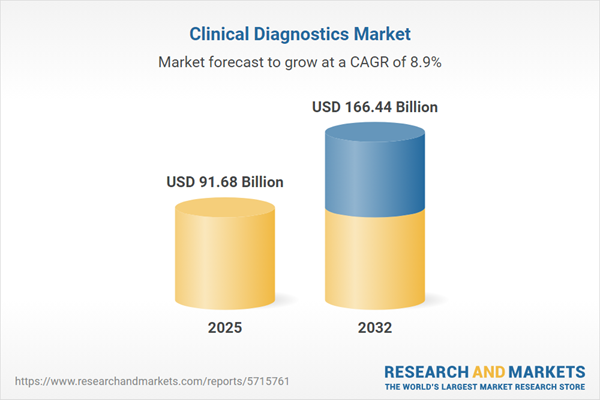Speak directly to the analyst to clarify any post sales queries you may have.
Senior executives in clinical diagnostics must navigate rapid innovation and complex regulatory shifts while driving operational efficiency. Strategic agility and proactive planning are key to sustaining growth and meeting diverse healthcare demands in this dynamic industry landscape.
Market Snapshot: Clinical Diagnostics Market Size & Growth Outlook
The global clinical diagnostics market is projected to advance from USD 84.17 billion in 2024 to USD 91.68 billion by 2025. With a compound annual growth rate (CAGR) of 8.89% through 2032, the sector is set to achieve a market value of USD 166.44 billion. Market expansion is supported by continuous advancements in assay development, increasing adoption of digital health platforms, and evolving regulatory environments. Companies that implement real-time analytics and advanced diagnostic technologies are strategically positioned to address emerging clinical challenges and strengthen their competitive standing in the global clinical diagnostics market.
Scope & Segmentation of the Clinical Diagnostics Market
Understanding how the clinical diagnostics market is segmented empowers leaders to optimize investments, allocate resources, and respond to shifting business needs. Market segmentation reveals the essential drivers influencing direction and adoption within the sector.
- Product Types: Chemistry analyzers, hematology platforms, immunoassay devices, molecular diagnostics systems, specialized reagents, diagnostic software, consulting services, and laboratory informatics tools each contribute to improved diagnostic accuracy and accelerated clinical workflows.
- Technologies: Electrochemical methods, photometric techniques, advanced hematology analysis, chemiluminescence, fluorescence immunoassays, polymerase chain reaction (PCR), isothermal amplification, and next-generation sequencing are instrumental in expanding laboratory capabilities and fulfilling wider clinical needs.
- Applications: Solutions encompass cardiovascular care, diabetes management, genetic and prenatal screening, infectious disease detection, and oncology, providing targeted support to clinicians and patients for high-quality outcomes.
- End Users: Clinical laboratories, hospital labs, research institutions, decentralized and point-of-care testing sites, and home-based diagnostics represent the diverse range of organizations driving adoption and accessibility across healthcare delivery models.
- Sample Types: Blood, tissue, saliva, and urine allow for comprehensive disease screening and facilitate precision testing tailored to personalized medicine approaches.
- Regions Covered: Americas, Europe, Middle East and Africa, and Asia-Pacific each present unique challenges related to supply chain resilience, regulatory requirements, and localization of solutions.
- Profiled Companies: Leading industry participants include F. Hoffmann-La Roche Ltd, Abbott Laboratories, Danaher Corporation, Siemens Healthineers AG, Thermo Fisher Scientific Inc., bioMérieux SA, Becton, Dickinson and Company, Sysmex Corporation, Bio-Rad Laboratories, Inc., and QIAGEN N.V., which set standards through their extensive portfolios and market presence.
Key Takeaways for Senior Decision-Makers
- Decentralized and point-of-care diagnostics solutions are expanding, enabling care providers to respond quickly and flexibly in diverse clinical settings.
- Artificial intelligence integrated with laboratory informatics delivers greater diagnostic accuracy and relevant, case-specific insights for complex clinical scenarios.
- Responding to evolving regulatory expectations demands strong data integrity, consistent transparency, and continuous product validation to sustain compliance and trust.
- Building robust supply chain resilience lowers operational risks and supports uninterrupted service delivery across multi-regional healthcare markets.
- Collaborative partnerships between device manufacturers and reagent suppliers help organizations adapt to market and regulatory changes while maintaining reliable product supplies.
- Offering integrated support services, including technical assistance and staff training, positions businesses to enhance client loyalty and manage market complexity efficiently.
Tariff Impact on Global Supply Chains
Recent U.S. tariff policy adjustments have prompted clinical diagnostics firms to reassess procurement and supply chain strategies. By aligning purchasing and logistics processes with new tariff frameworks, organizations can enhance operational flexibility, manage costs effectively, and ensure consistent solution delivery amid global disruptions.
Methodology & Data Sources
This clinical diagnostics market analysis incorporates executive interviews, insights from laboratory leaders, company filings, regulatory datasets, and independent third-party market research. Thorough cross-verification throughout the research process ensures the accuracy and reliability of findings for strategic planning.
Why This Report Matters: Decision Impact
- Gain tailored recommendations for investment and regulatory planning based on objective, in-depth market analysis in high-potential segments.
- Leverage actionable insights regarding regional trends and supply chain considerations to develop effective business strategies and capitalize on new opportunities.
- Maintain adaptability in technology adoption, compliance, and evolving business models, enabling leadership to keep pace with ongoing market change.
Conclusion
This report provides practical guidance for navigating the complexities of clinical diagnostics, supporting business resilience, and promoting sustainable growth amid industry transformation.
Additional Product Information:
- Purchase of this report includes 1 year online access with quarterly updates.
- This report can be updated on request. Please contact our Customer Experience team using the Ask a Question widget on our website.
Table of Contents
3. Executive Summary
4. Market Overview
7. Cumulative Impact of Artificial Intelligence 2025
Companies Mentioned
The companies profiled in this Clinical Diagnostics market report include:- F. Hoffmann-La Roche Ltd
- Abbott Laboratories
- Danaher Corporation
- Siemens Healthineers AG
- Thermo Fisher Scientific Inc.
- bioMérieux SA
- Becton, Dickinson and Company
- Sysmex Corporation
- Bio-Rad Laboratories, Inc.
- QIAGEN N.V.
Table Information
| Report Attribute | Details |
|---|---|
| No. of Pages | 182 |
| Published | November 2025 |
| Forecast Period | 2025 - 2032 |
| Estimated Market Value ( USD | $ 91.68 Billion |
| Forecasted Market Value ( USD | $ 166.44 Billion |
| Compound Annual Growth Rate | 8.8% |
| Regions Covered | Global |
| No. of Companies Mentioned | 11 |









